|

a



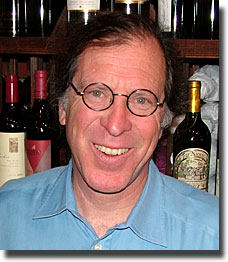 here
is perhaps no more singular character in the California wine scene than
Randall Grahm, of
Bonny Doon
Vineyards. A maverick winemaker with unique (some might say
eccentric) tastes and opinions, Grahm was one of the original Rhône
Rangers, those Left Coast vintners who eschewed the fashionable
varietals (Cabernet Sauvignon and Chardonnay)
back in the early ‘80s for what were then the more obscure Syrah,
Grenache and Mourvedre. Add to that the fact
that there has probably never been a winemaker who has employed humor
more effectively, and/or hilariously, in marketing his wares, and you
have just a few aspects the complex personality of this self styled,
vinous Mad Hatter. here
is perhaps no more singular character in the California wine scene than
Randall Grahm, of
Bonny Doon
Vineyards. A maverick winemaker with unique (some might say
eccentric) tastes and opinions, Grahm was one of the original Rhône
Rangers, those Left Coast vintners who eschewed the fashionable
varietals (Cabernet Sauvignon and Chardonnay)
back in the early ‘80s for what were then the more obscure Syrah,
Grenache and Mourvedre. Add to that the fact
that there has probably never been a winemaker who has employed humor
more effectively, and/or hilariously, in marketing his wares, and you
have just a few aspects the complex personality of this self styled,
vinous Mad Hatter.
Randall passed through Detroit and surrounding environs during the
first few days of August, and I had the chance to sit down with him
and talk about where he’s been and where’s he’s headed.
GoP: So Randall, how long is this road trip?
RG: Just about a week, but it’s a very long week. I think there’s
about 40 days in this particular week.
GoP: Are you hitting Michigan? Ohio? The Midwest?
RG: The Midwest; St. Louis, Michigan, Chicago and
Minneapolis.
GoP: Can you tell me a little about your background before Bonny Doon
came into being?
RG: There was no background before Bonny Doon came into being. I
was just a kid playing childhood games. I was a student, kind of a
permanent Liberal Arts major, one of those students on the 12 – year
plan (who) changed majors about every other year, and I just happened
into a wine shop back in 1975, and owing to a concatenation of
circumstances, was exposed to the most extraordinary wines in the world,
and that’s sort of what got me interested in wine as a career.
GoP: And how did you actually start making wine?
RG: Well, I went back to school at UC Davis after working
in the wine shop, and they did their best, they did what they could,
they attempted to teach me about winemaking. I, of course, thought I
knew everything. I knew nothing, and I was very fortunate to have
extremely kind, beneficent parents who helped me get started with Bonny
Doon. And ultimately, I just dove in and made tons of mistakes.
Fortunately, in those days, the wine business was a lot more forgiving
than it is now, so I was able to muddle through and get to wherever it
is that we are now.
GoP: When did you start Bonny Doon?
RG: 1981.
GoP: 1981; so, it’s been a long, strange trip, as some of our pop
icons once put it.
RG: Exactly. If it hadn’t already been said, that’s exactly how I
would have phrased it.
GoP: You’ve never been a Cabernet – Merlot – Chardonnay kind of guy.
You were working with Rhone varietals before almost anyone else in
California, and you have a penchant for making wine from grapes that
nobody else seems to have much use for. What is it about the likes of
Malvasia, Barbera and such that you find so appealing?
RG: Well, I went to school the first time at the University of
California in Santa Cruz, or as we called it in those days, Uncle
Charlie’s Summer Camp. (It was the) early ‘70s, there were no letter
grades; there were instead what were called narrative evaluations. So,
no letter grades, parts of each day at the beach…, there’s a certain
genre of student who’s highly attracted to this proposition, and I would
characterize the student thusly: highly intelligent, very sensitive,
socially retarded and lazier than shit. In other words, your classic
underachiever – late bloomer, and I’m totally convinced that my
experience at UCSC has given me an acute sensitivity to what I call “the
ugly duckling” grape varieties of the world, and I am their champion,
and will remain so.
"I write the
newsletters, I do the funny, weird literary parodies and things like
that, but John (Locke) actually does Randall better than Randall, at
this point."
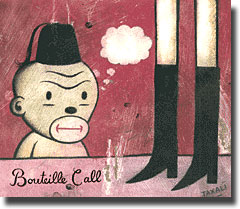 GoP:
Your labels, newsletters and website are always a riot, and it seems
pretty obvious that your use of wacky humor in just about every aspect
of marketing Bonny Doon is an extension of your personality. Where does
all this zaniness comes from? Do you yourself actually come up with
everything we read on those labels, newsletters and the website? GoP:
Your labels, newsletters and website are always a riot, and it seems
pretty obvious that your use of wacky humor in just about every aspect
of marketing Bonny Doon is an extension of your personality. Where does
all this zaniness comes from? Do you yourself actually come up with
everything we read on those labels, newsletters and the website?
RG: It used to be, but it actually is no longer. I have a very
brilliant colleague, John Locke, who
is responsible for a lot of the content on the web. I’m just a
pretty web illiterate person, I mean I can barely navigate the web
myself. John is really responsible for a lot of that, and also a lot of
the marketing. He is really a marketing genius. I write the newsletters,
I do the funny, weird literary parodies and things like
that, but John actually does Randall better than Randall, at this point.
GoP: Looking at your labels, it appears that you use fruit from your
own vineyards for wines like
Cigare Volant,
Old Telegram and
Cardinal Zin, and purchased fruit for bottlings such as the
Big House Red and
White. Is that accurate, and if so, what percentage of your own
grapes do you use, as opposed to purchased fruit?
RG: Alas, that is not accurate; WOULD that we used entirely our
own grapes for Cigare Volant, Old Telegram and such. For the moment, our
own vineyard, which is in Soledad, California,
primarily goes into
Dewn wines, which are wines we sell to our clientčle particulare,
and they sort of find their way into experimental wines and other blends
and such. But, Cigare Volant, which is based on Rhône varieties, is made
entirely from purchased fruit. Our vineyard in Soledad is just not
really warm enough to do most… well that’s actually not true, we are
going to Syrah, and a little bit of that does go into Cigare Volant. We
ARE growing some Syrah, and we ARE growing Grenache, but it’s way too
cool for Mourvedre. So, to answer your question, we purchase 92 or 93%
of our grapes, and we grow about 7%. The percentage needs to be
reversed; we need to grow 93% of our grapes and purchase 7%.
GoP: Is that part of the plan down the road?
RG: That is part of the plan. How precisely we’re going to get
there, I can’t tell you, but that is the plan.
"I came to Stelvins almost as a matter
of default, but the more research I did, the more I was persuaded that
it was a brilliant closure, and the only real issue was whether the
consumers would accept it."
GoP: You’ve embraced the Stelvin ™
enclosure over the past few years; are all of your wines now fitted with
screwcaps?
RG: Virtually all the wines; only the things that don’t go to
screwcap are some of the oddball sizes, some of the magnums, but
essentially, 100% of our wines are screwcaps. And then some of the wines
that we import, the producer doesn’t necessarily have the equipment to
bottle in Stelvin ™.
GoP: I think I know what you’re going to say, but I have to ask
anyway; why have you gone the way of the screwcap?
|
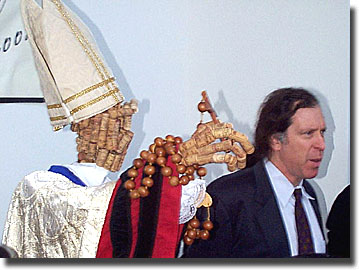
Cardinal Zin bestows his
blessing at ZAP '03, as Randall surveys the throngs
clamoring for an angry young zin.
|
RG: Well, there is no single reason, all of our reasons are multi
– factorial. I was just completely fed up with corks for a long time,
and tried to find an alternative, and one of the things that I went to
was the synthetic closures, the plastic closures. It seemed like a good
idea at the time. Unfortunately, I was very disappointed with the
performance of the synthetic closures, they just seemed to allow the
wines to develop far too rapidly. It was a non – issue for things like
Vin Gris and Big House that were going to be consumed in a year
or two after bottling, but for things like Cigare Volant that were
capable of aging, it was not the right solution. So I came to Stelvins
almost as a matter of default, but the more research I did, the more I
was persuaded that it was a brilliant closure, and the only real issue was whether the consumers would accept it. But
as far as its performance, there was never really any question about
that. Therefore, it was a bit of a gamble to bottle Big House as we did
in Stelvin, but it was definitely a gamble that has worked out really,
really well, and we’re thrilled with it. Our customers think it’s great;
it’s just turned out to be a surprising non – issue for most people.
GoP: And you’re convinced that Stelvin will hold up for extended
aging?
RG: Yes, I’m totally convinced of it. For whatever reasons, not
the least of which is that there’s actually less oxygen exchange… there
is still some, but less than in a cork sealed bottle; and really, the way
that Stelvin performs is like a magnum or double magnum, which obviously
still continues to evolve, but just at a slower rate, and all things
being equal, if you can slow down the maturation of a wine, ultimately,
you’ve increased the longevity of the wine, and you enable it to reach
its fullest potential.
"I sort of have fantasies about
relocating to Europe at some point in the near or distant future, and so
I wanted to see if I could function over there, and I think the answer
is yes, I can perfectly well."
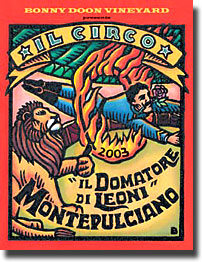 GoP:
How did the
EuroDoon line of wines come about? GoP:
How did the
EuroDoon line of wines come about?
RG: Well, it’s sort of amazing to see right now, but again, like
everything else, the camel gets his nose in the tent, and before you
know it…
It really began because I wanted to make a Syrah, I loved Syrah, I was
crazy about Syrah, (and) I couldn’t find any Syrah in California that I
really wanted. There was just a shortage of grapes, they were very
expensive and not very good, and so I went to France to look for Syrah,
which is abundant of course. Now, the situation is totally different,
everybody and their neighbor’s growing Syrah. But that’s how I got into
it, and it starts as almost a kind of an experiment to see how I would
fare in France. I sort of have fantasies about relocating to Europe at
some point in the near or distant future, and so I wanted to see if I
could function over there, and I think the answer is yes, I can
perfectly well. I occasionally do interviews for French TV and radio,
and I’m totally convinced that these poor people are adjusting their
dials, like “What is he talking about, what is he saying?! Is he
speaking French?!”
GoP: I seem to have noticed that a couple of the French producers
that you started with, you don’t have anymore, and you’ve gone to some
Italian producers?
RG: Well, I’d say that we’ve pretty much stuck with the people
that we’ve been with. Like everything else at Bonny Doon, nothing ever
gets dropped, we just augment, so we are continuing with pretty much our
original producers Domaine des Blagueurs
and
Heart of Darkness, but we’ve augmented that with the
Il Circo line, which are the range
of oddball Italian grapes.
GoP: How much input do you have with your European producers? Do they
have carte blanche, or do you collaborate with them?
RG: In some cases it’s a collaboration, and in some cases it’s
carte blanche. It’s carte blanche for the people who know what they’re
doing far better than I know what they’re doing, and for whom I would
only muck things up, so there’s no point in me mucking it up. Where I
feel I can make an improvement or suggestion, I do, but I think at this
point, it’s not exactly on auto – pilot, but it’s running pretty
smoothly without a lot of meddling on my part.
"The problem with Ralph is that he’s
totally brilliant."
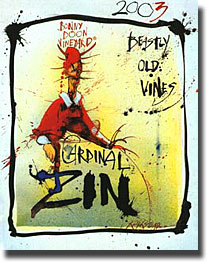 GoP:
As an old Hunter S. Thompson fan, I was geeked the first time I saw a
Cardinal Zin label. How did you hook up with Ralph Steadman? GoP:
As an old Hunter S. Thompson fan, I was geeked the first time I saw a
Cardinal Zin label. How did you hook up with Ralph Steadman?
RG: Oh, that was kind of fortuitous. We were doing a lot of
business with Odd Bins, which is a chain in the UK, and Ralph did all of
their publicity, just TOTALLY brilliant publicity. So they sort of made
the connection, and I learned that he is a real wine geek himself, and
we hit it off, and I proposed that he do some labels for us, and he
amazingly acceded to my request.
He’s totally brilliant. The problem with Ralph is that he’s totally
brilliant. All you can really propose to Ralph is the name of the wine
and the approximate dimensions of the label, and beyond that, it’s
really not worth saying too much more.
GoP: Are there any other winemakers that you like to hang out with
when you have the time? I have this idea in my brain that you’d get on
well with guys like
Jim Clendenen and
Sean Thackrey.
RG: Well, I DO get on well with Jim Clendenen and Sean Thackrey;
actually, those are my two buds in the wine business, the two guys I
really respect the most in the New World. I’m just really not much of a
social person, or maybe just kind of slightly shy and withdrawn, but
most of my winemaking friends actually are European. I just don’t really
know a lot of American winemakers.
GoP: My memory is a little sketchy on the matter, but I seem to
recall that you had plans to move the Bonny Doon winery to a different
location a while back, with the property already selected, and then it
all fell through. Can you talk a little about what happened?
RG: Sure. That is correct, I got it into my mind to relocate the
winery to Pleasanton, California; this is after our vineyard in Bonny
Doon, in the Santa Cruz Mountains succumbed to
Pierce’s Disease, which I sort of perceived as almost a Biblical
sign. You know, “Randall, get thee forth!”
This is the old
Ruby Hill site, (an) historical vineyard. I had such a strong
feeling about it; I had lots of imaginative fantasies about what I was
going to do there, and the deal really almost came through, it came THIS
close to going through, but it turns out there were some serious Feng
Shui issues relative to the property, and I brought in a Feng Shui
consultant, and he cautioned me against some of the untoward issues, and
the deal just kind of unraveled at the very, very last minute.
GoP: What kind of Feng Shui issues? Can you elaborate?
RG: Well, it turns out that there were actually spirits
inhabiting the old winery, and I’m not just making this up, this was
really corroborated by everyone who worked at the winery; there were
ghosts at the old Ruby Hill Winery, and that of course required a lot of
adaptation of our plans. We couldn’t build the winery where we wanted
to, we had to move it someplace else, and there were issues with the
water rights with a neighbor and with riparian rights and right of way
and things like that. So, it’s like a lot of seeming soluble issues
accumulated to the point where it just tipped the balance the wrong way
on that particular deal.
GoP: And as far as the vineyards in the Santa Cruz Mountains that had
Pierce’s Disease, were those ever replanted?
RG: Well, I sold the property, which, in retrospect, was probably
a very, very poor idea, given that real estate has quintupled since I
did this. We got wiped out by the wimpy sharpshooter, the blue green
sharpshooter; this is before the era of the glassy winged
(sharpshooter), which is like ten times more devastating. So, we got
wiped out by the wimpy bug, and I thought, “Oh my God, we’re finished.”
Being the “half empty” kind of guy that I am, I decided, “Finito, time
to move on, Randall.” I should have stuck it out, because, mind you,
this is an extraordinary place, it’s a wonderful place to grow grapes.
GoP: So, what’s in the future for Randall Grahm and Bonny Doon?
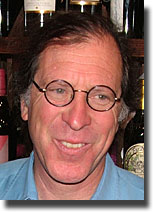 RG:
Excellent question. Of course, nobody really knows what the future will
be, but, for me personally, I feel that I’m extremely proud of what
we’ve accomplished, but with the caveat that I think that I built the
winery kind of backwards. In other words, I, and especially my colleague
John, are really good at marketing, I mean we’re so good, it just isn’t
fair to other people. And so, because we’re so good, you do what you’re
good at, and we’re really good at marketing, so that’s what we did, and
I think as a result, Bonny Doon grew somewhat out of synch with itself.
I think, in retrospect, we should have paid more attention to the real
foundation of the business, which are the grapes that you work with, and
that should have taken logical precedence over the whole marketing schtick. But again, I was sort of feeling my way, and I really didn’t
know any better. Now, I’m at a point where what I most want to do is
revisit all of our grapes, and work with all of our growers, and really
bring them to a much higher level and this is an extreme challenge,
given the size of the company right now, but something we have to
address. RG:
Excellent question. Of course, nobody really knows what the future will
be, but, for me personally, I feel that I’m extremely proud of what
we’ve accomplished, but with the caveat that I think that I built the
winery kind of backwards. In other words, I, and especially my colleague
John, are really good at marketing, I mean we’re so good, it just isn’t
fair to other people. And so, because we’re so good, you do what you’re
good at, and we’re really good at marketing, so that’s what we did, and
I think as a result, Bonny Doon grew somewhat out of synch with itself.
I think, in retrospect, we should have paid more attention to the real
foundation of the business, which are the grapes that you work with, and
that should have taken logical precedence over the whole marketing schtick. But again, I was sort of feeling my way, and I really didn’t
know any better. Now, I’m at a point where what I most want to do is
revisit all of our grapes, and work with all of our growers, and really
bring them to a much higher level and this is an extreme challenge,
given the size of the company right now, but something we have to
address.
I’m very fortunate to have discovered the practice of
Biodynamics along the way, and we’ve adopted
La Biodynamie in our old vineyard in
Soledad, and it has made a huge difference. We are actually now growing
grapes that not only am I not ashamed of, but I actually think are
really cool. I’m sort of an Old World guy kind of trapped in a New World
life, which is to say I just love Old World wines. I love their
soulfulness, the fact that they bespeak a sense of place and they
express minerality. That, to me, is what makes wine interesting. And I
do believe that La Biodynamie is one of the
most efficient routes toward the discovery of terroir and producing
wines that express a sense of place. So, this is what I want to do; now
the question is, how do we do it, how do we get our growers to think
about adopting La Biodynamie sincerely, not
just as a way of pleasing me or trying to make money, but out of a real
longing to do the right thing viticulturally. This is the future of
Bonny Doon, to produce wines that really have a strong sense of place.
Reporting from Day-twah,
Bastardo
|
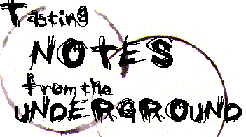
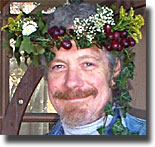

 here
is perhaps no more singular character in the California wine scene than
Randall Grahm, of
here
is perhaps no more singular character in the California wine scene than
Randall Grahm, of
 GoP:
Your labels, newsletters and website are always a riot, and it seems
pretty obvious that your use of wacky humor in just about every aspect
of marketing Bonny Doon is an extension of your personality. Where does
all this zaniness comes from? Do you yourself actually come up with
everything we read on those labels, newsletters and the website?
GoP:
Your labels, newsletters and website are always a riot, and it seems
pretty obvious that your use of wacky humor in just about every aspect
of marketing Bonny Doon is an extension of your personality. Where does
all this zaniness comes from? Do you yourself actually come up with
everything we read on those labels, newsletters and the website?
 GoP:
How did the
GoP:
How did the
 GoP:
As an old Hunter S. Thompson fan, I was geeked the first time I saw a
Cardinal Zin label. How did you hook up with Ralph Steadman?
GoP:
As an old Hunter S. Thompson fan, I was geeked the first time I saw a
Cardinal Zin label. How did you hook up with Ralph Steadman? RG:
Excellent question. Of course, nobody really knows what the future will
be, but, for me personally, I feel that I’m extremely proud of what
we’ve accomplished, but with the caveat that I think that I built the
winery kind of backwards. In other words, I, and especially my colleague
John, are really good at marketing, I mean we’re so good, it just isn’t
fair to other people. And so, because we’re so good, you do what you’re
good at, and we’re really good at marketing, so that’s what we did, and
I think as a result, Bonny Doon grew somewhat out of synch with itself.
I think, in retrospect, we should have paid more attention to the real
foundation of the business, which are the grapes that you work with, and
that should have taken logical precedence over the whole marketing schtick. But again, I was sort of feeling my way, and I really didn’t
know any better. Now, I’m at a point where what I most want to do is
revisit all of our grapes, and work with all of our growers, and really
bring them to a much higher level and this is an extreme challenge,
given the size of the company right now, but something we have to
address.
RG:
Excellent question. Of course, nobody really knows what the future will
be, but, for me personally, I feel that I’m extremely proud of what
we’ve accomplished, but with the caveat that I think that I built the
winery kind of backwards. In other words, I, and especially my colleague
John, are really good at marketing, I mean we’re so good, it just isn’t
fair to other people. And so, because we’re so good, you do what you’re
good at, and we’re really good at marketing, so that’s what we did, and
I think as a result, Bonny Doon grew somewhat out of synch with itself.
I think, in retrospect, we should have paid more attention to the real
foundation of the business, which are the grapes that you work with, and
that should have taken logical precedence over the whole marketing schtick. But again, I was sort of feeling my way, and I really didn’t
know any better. Now, I’m at a point where what I most want to do is
revisit all of our grapes, and work with all of our growers, and really
bring them to a much higher level and this is an extreme challenge,
given the size of the company right now, but something we have to
address.